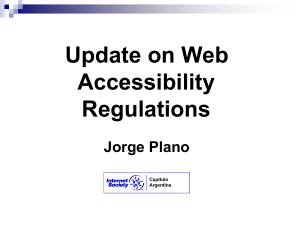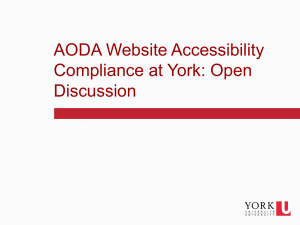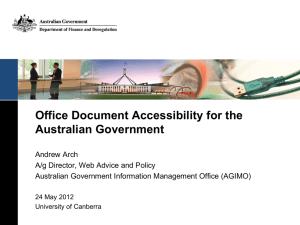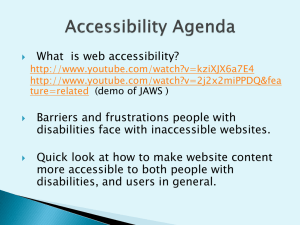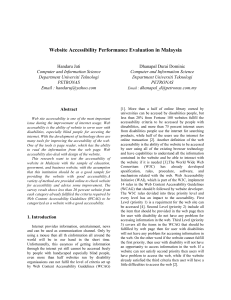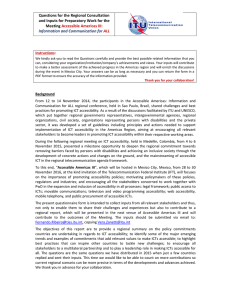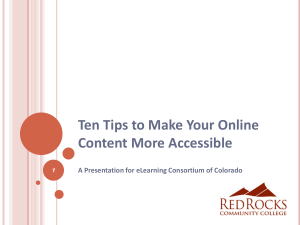Warm Molasses: The Section 508 Refresh
advertisement
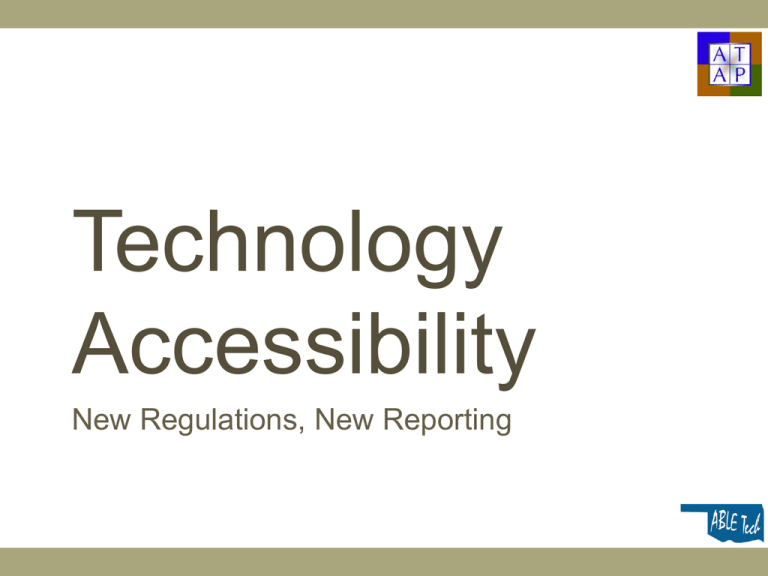
Technology Accessibility New Regulations, New Reporting Technology Accessibility • Technology is everywhere! • Ensure that people with disabilities can use Information and Communication Technology (ICT) • With or without assistive technology • Account for different interactions with technology Section 508 • Part of Federal Rehabilitation Act • Information and Communication Technology (ICT) procurement policy • Directly applies to federal government and contractors • Applies to state governments that receive funding through Technology Related Assistance for Individuals with Disabilities Act of 1988 • Foundation for several state laws and policies What’s This Refresh? • Started in 2006 by U.S. Access Board • Goals • Update technical standards • Clarify regulation and applicability What’s Going On? • Notice of Proposed Rulemaking published in February • (Probably) final draft of refreshed Section 508 (http://www.access-board.gov/guidelines-andstandards/communications-and-it/about-the-ict-refresh/newsrelease) • Public comment period closed May 28 • Expect new Rule late summer/fall • Implementation period to follow WHAT IS IN THE REFRESHED RULE? Some New, Some Old New Standards! • Web Content Accessibility Guidelines (WCAG) 2.0, Level AA included by reference • No more US-only standards • PDF/UA-1 included by reference • Specific to PDF documents Specific Applicability! • • • • Web Installed software, operating systems Mobile Non-web ICT • Digital documents like Word, PDF, PowerPoint (more later…) • Hardware • Closed systems, like information kiosks • Agency Official Communications Functional Performance Criteria • Reminder that standards are about people • • • • • • • • Without vision With limited vision Without perception of color Without hearing With limited hearing Without speech With limited manipulation With limited reach and strength Closed Products • Cannot add or attach assistive technology • Kiosks, self-service machines • Speech output • Volume control • Character specifications • Sans serif font, for example Additional Considerations • Biometrics • Standard connections for assistive technology • Operable parts • Keyboard keys with contrasting letters • One “tactilely discernable” input control • Nib on a keyboard • Real-time speech must provide real time text • Must support audio descriptions IS THIS AN IMPROVEMENT Preview Answer: Yes! WCAG 2.0, Level AA • More modern and flexible • Harmony • Referenced, not incorporated into draft 1998 • • • • • WCAG 1, more focused on specific technology Star Trek: The Next Generation on TV in first run Desktop computers Mainframes Huge floppy disks 2015 • • • • • • • WCAG 2, more focused on function Desktops Laptops Tablets Smartphones Phablets JavaScript Challenges, New and Old • Little focus on people with cognitive disabilities, low vision • Inherited from WCAG • Multimedia accessibility • Adjustment for those that work with current 508 MORE CHANGES Performance Measure Data, Accessibility, and You New Reporting Requirements • ICT accessibility as a Performance Measure • Focus on training outcomes from participants • Policy, procedure, or practice improvement • Training or technical assistance development • Unknown Opportunities • Create more technology accessibility awareness • Increase skills and understanding • Ours and our audiences’ • Help our states to meet obligations • Americans with Disabilities Act • Federal Rehabilitation Act • State statutes Challenges • • • • We’re awesome at AT, but this accessibility thing? Where to start? Where to go? How do we build this expertise? You Are Not Alone! • ATAP training you to train • Webinar series of the past • Monthly • Focus on introduction, accessibility in Word, PowerPoint, and multimedia • Webinar series of the future… • What topics will help you? • What will motivate you to participate? • What formats work best? • How much notice do you need? Rough Ideas • • • • Every other month Survey or surveys to see what will help Regular schedule Variety of topics under ICT accessibility umbrella • Testing • Standards • Organizational implementation Questions? Rob Carr, Accessibility Coordinator rgcarr@okstate.edu Oklahoma ABLE Tech Oklahoma State University 1-888-885-5588 @OKABLEtech, @rgcarrjr on Twitter


